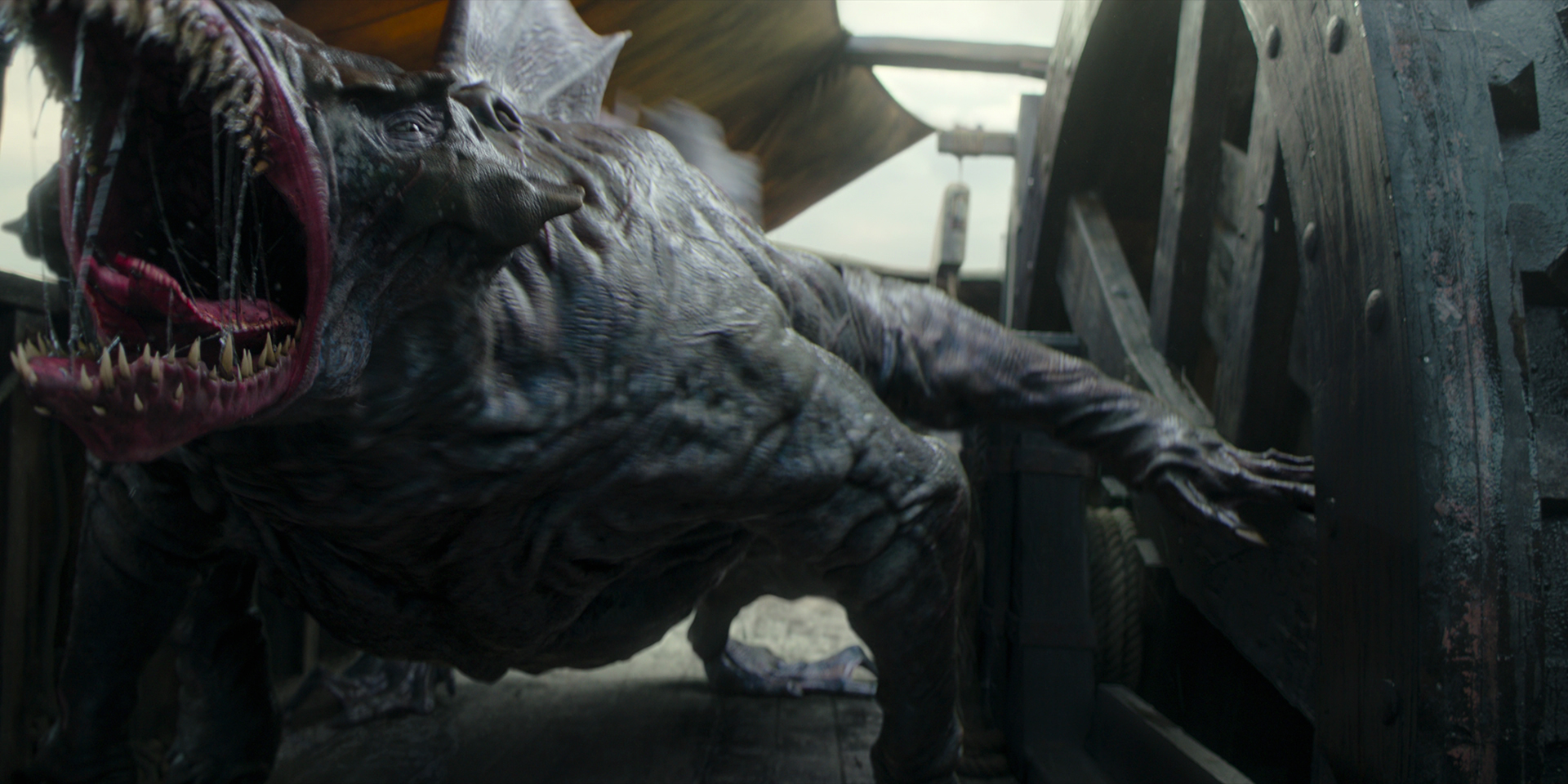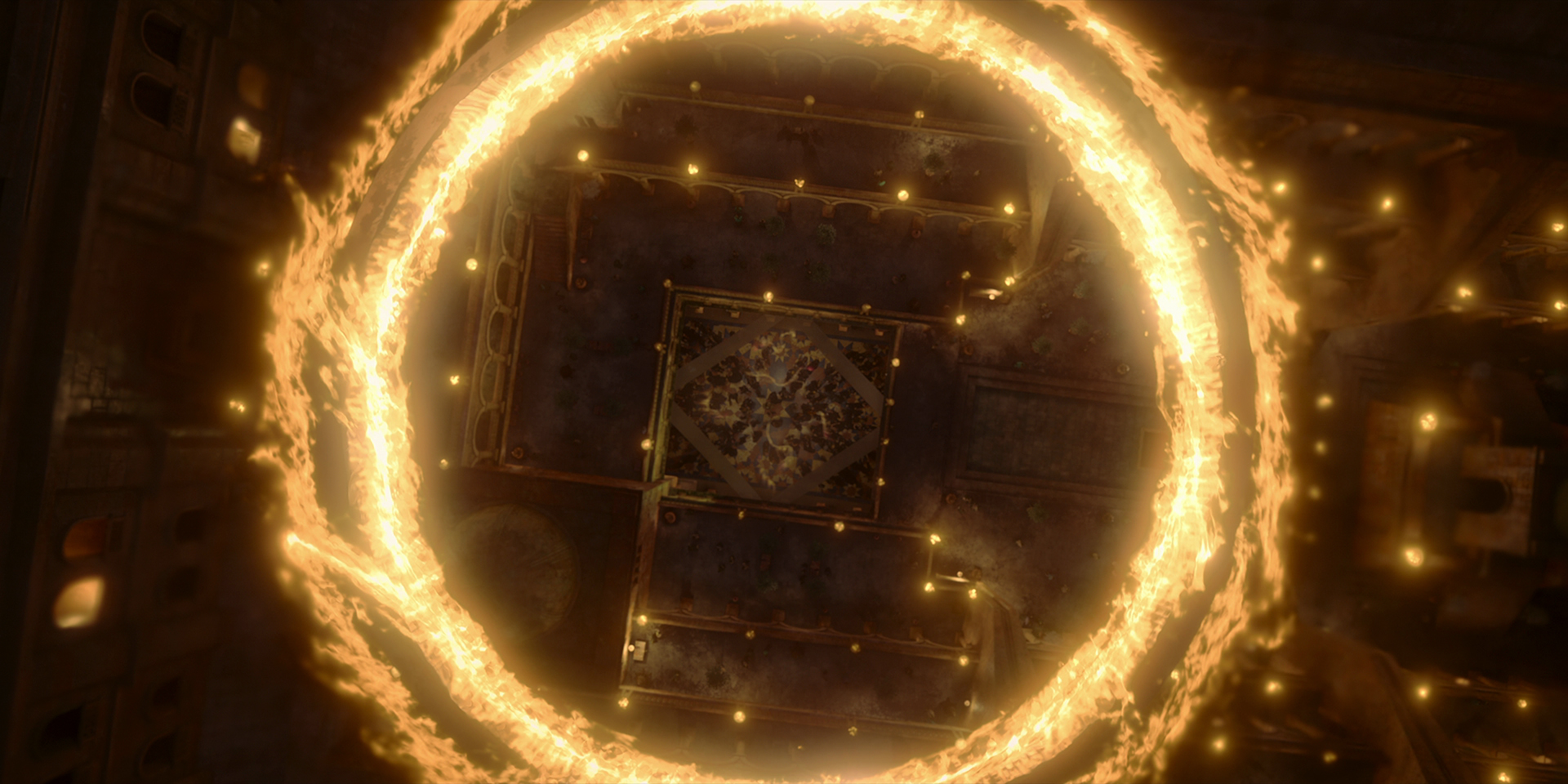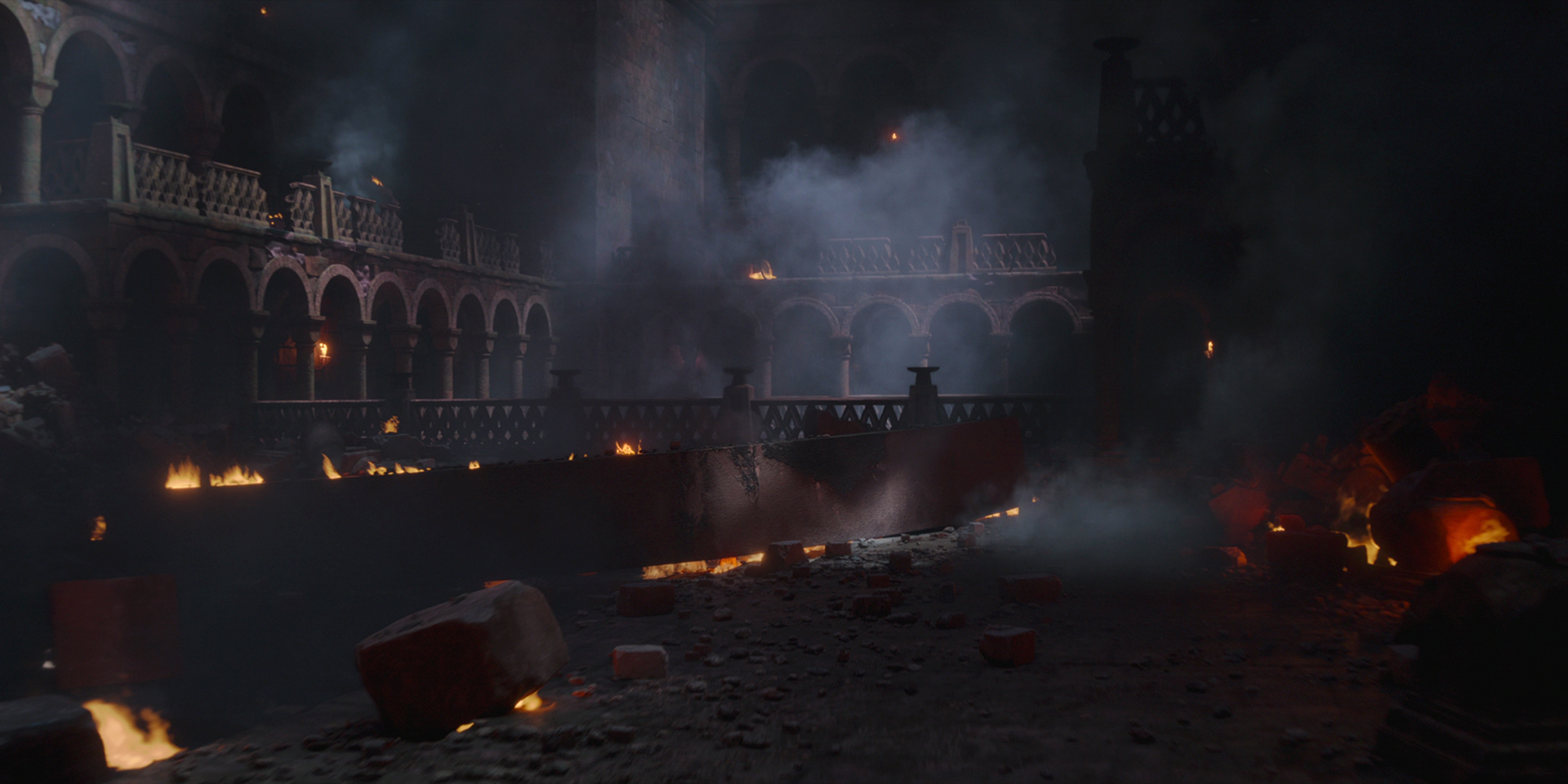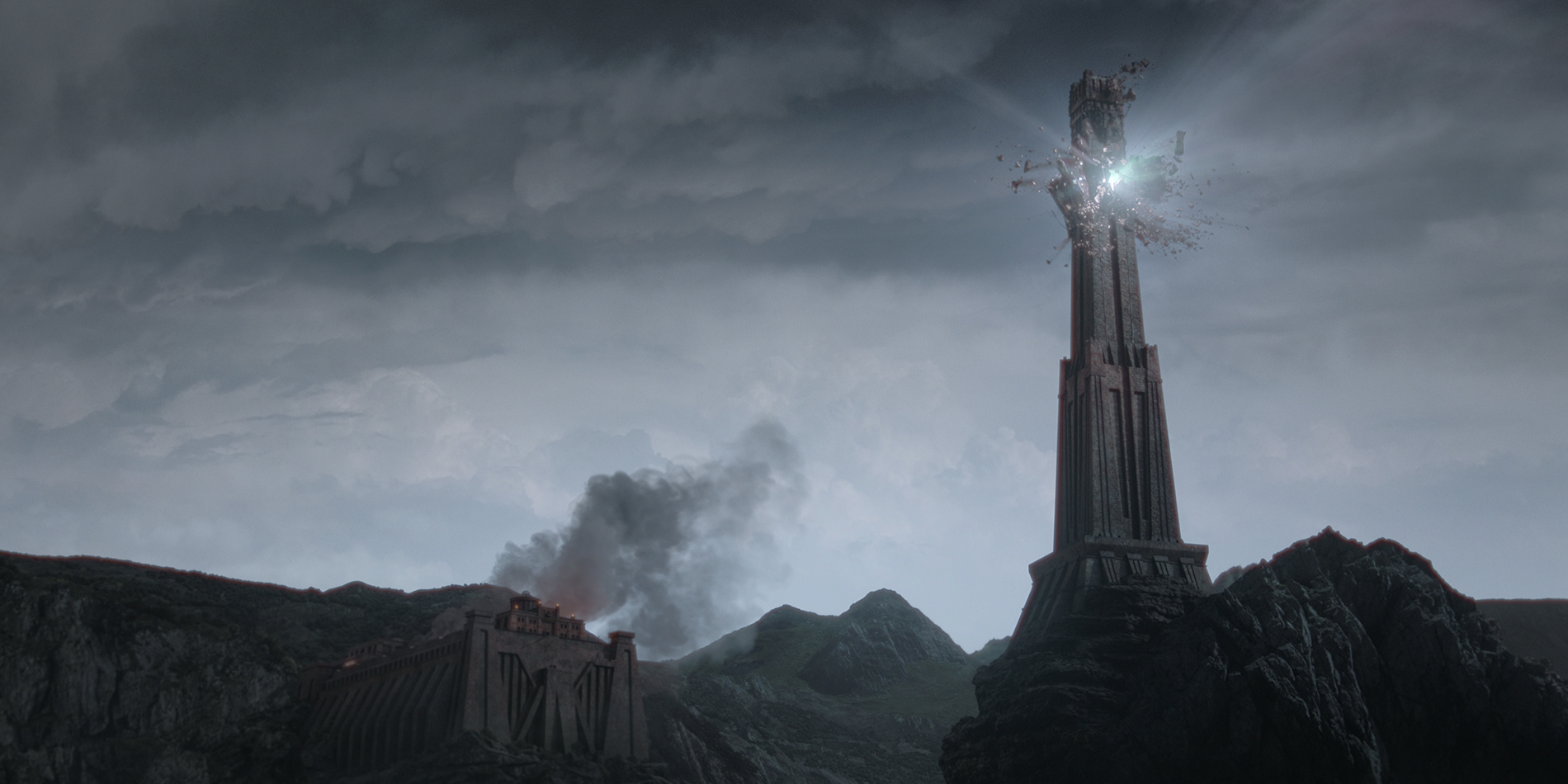
The third season of The Witcher opens with Geralt, Yennefer and Ciri on the run from monarchs, mages and beasts of the Continent, all competing to capture Ciri. Having created the terrifying Basilisks, Chernobog, Kikimora and Striga for previous seasons and received a BAFTA for our work on the second season, the challenge was laid for us to create weirder and more horrifying creatures than audiences have seen before.
Cinesite VFX Supervisor Richard Reed and CG Supervisor Samir Ansari share fascinating insights into Cinesite’s work on the third season; The Flesh Monster, Aeschna, Ring of Fire and Aretuza Destruction.
The Aeschna
The battle with the Aeschna takes place on a chain ferry which is taking Geralt and Ciri to Aretuza. The creature leaps suddenly and terrifyingly from the water onto the confined deck, seizing one of the passengers. Ciri fights the creature, with support from Geralt.
How was the sequence filmed and the look of the Aeschna conceived?
Richard: I was on set with studio VFX supervisor Tim Crosbie while they filmed the action on a 180 ft wide partial set at Longcross Studios, against a blue Cyclarama. The production had previsualised the sequence and this was used as reference by the stunt team in choreographing the fight. Some aspects of the fight changed during filming, but for the most part it remained similar.
Original designs for the Aeschna came out of the art department and they were pretty close to the finished look, although the creature initially had a head resembling a goblin shark. We reworked the design to better fit the requirements of the sequence and to give it a bigger jaw and bite, which was more threatening. Production had built a giant maquette of the tail for lighting reference and to give a general sense of the creature’s scale on set. We used various amphibian references, including frogs and salamanders for skin texture, looking carefully at the surface patination, pores and wrinkling.
Towards the end of the Aeschna sequence the creature’s tail catches in the chain ferry’s gear mechanism and is ripped off so that we see its inner muscles and bones. We needed to create three creature assets: the full uninjured Aeschna, the Aeschna without tail and finally, the dismembered tail.
Since the creature is progressively injured throughout the fight with Ciri, a progressive damage system was required to ensure, through careful planning, the introduction of each damage variant at the correct beat in the choreography, blending transitions until the final, tail-less and life-less version. Time was tight and the CFX required for the creation of the tail were complex, needing convincing blood and internal anatomy.
How was the Aeschna’s movement handled?
Richard: The Aeschna was pretty big for the confined space on the boat, and that presented some challenges in terms of scale and choreography. The production had added tarpaulin to the sides of the boat to raise them up higher, reducing the amount of edge work required for the sea and distant environment. However, we needed to avoid creature interaction with those tarps to reduce the need for additional FX. This added to the scale and positioning challenges and there were times where it was difficult to place the virtual cameras within the available space without the creature projecting out through the camera. Having said that, the result is a sense of claustrophobia which enhances the sense of threat.
Early walk cycles showed the Aeschna moving low to the ground like an alligator or crocodile. The team explored ways to make the creature dynamic and worked with key poses as an important part of the process. The Aeschna was animated on a shot-by-shot basis, depending on the needs of the fight choreography as well as the limitations of the deck space. Whilst the creature is slow and heavy, it needed to be credibly dangerous and convincingly difficult to kill. It has six legs which are close to the ground and we added small bear-like claws at the front and a mouth which snaps like an alligator to ramp up the threat.
How about the use of fluids in the sequence?
Richard: The Aeschna leaps onto the deck directly from the sea, so when it lands it’s still wet, but drying progressively throughout the sequence. We showed that by creating three different wetness looks. Most of the time we used the shiniest (wettest) version to give the glistening skin stand out from the deck, since the creature was quite dark. The compositing team did some great work incorporating the creature’s wet footprints on the deck, blood splats, water flicks etc., all of which really help sell the sequence.
Samir: There are two specific styles of water. Firstly, there is the full CG water ocean extension and secondly, there is performance-driven water like splashes from the wet creature onto the deck. The ocean water was a challenge because we needed to accurately simulate the boat speed to have it react realistically with the water surface. We created 300-400m of water surrounding the boat and made sure it would stand up to the camera getting close to its surface.
The supporting water work with the Aeschna was the most complex. The Aeschna is moving very quickly and in order for the water to be visible, we almost had to treat it hyper-realistically, playing with the lighting and even with gravity. Where we first see the creature as it jumps from the water onto the deck, a number of layers of water simulation were required; it’s bright daylight, the camera is close to the action and the water needed to be very realistic. We had a short turn-around and the animation was changing right up until the end; we did not have time to re-simulate every aspect. Ultimately, we split the water into two types; that which was affected by the creature’s performance and that which was not. This helped us ensure we would deliver the sequence on time.
We created the drool inside the creature’s mouth, considering small details like the air bubbles inside its mouth and adding the correct level of viscosity to the saliva. We designed the Aeschna’s blood to be green, as requested by the client. But because it wasn’t immediately recognisable in terms of colour, we needed to make sure that it clumped and behaved like blood.
The Flesh Monster
In the second episode of the season, Geralt encounters the Flesh Monster in the dungeons of Vuilpanne Castle, a horrific fusion of the torsos and limbs of women captured and experimented on by the powerful sorcerer Vilgefortz.
How was the look of the Flesh Monster developed?
Head of Assets and Visual Development Maddie Scott-Spencer, and Senior Creature Sculptor Jonathan Reilly worked with the initial brief of creating a creature with multiple human bodies fused into one, taking some of the original poses and interesting aspects of the production’s concept art, adapting and remixing them into a series of ZBrush concepts. We also received some previsualisation which used the idea of the body as a solid core of flesh, but it didn’t have enough reach and range to be threatening. The fight was choreographed with three stunt fighters performing side by side, so we knew it would be wide, but we needed to find a way of giving it the height it needed to appear intimidating.
Firstly, we needed to consider how many women the Monster would be made up from. We ended up with limbs and sections of between five and seven women. There would always be one body trailing to the rear of the torso facing the wrong way; this helped us to figure out our bearings, since this creature can flip on its axis. This trick is very dangerous for any opponent – just when you think you know what you’re fighting, it flips over and you’re confronted with something else. That rear torso is the first one to be stabbed, and from that point on it’s being dragged around behind the creature.
How about the Flesh Monster’s anatomy and movement?
Richard: Influences for the creature’s anatomy were wide-ranging and interesting, including the elongated limbs of people with connective tissue disorders, double-jointed limbs and also polydactylism.
Figuring out how the creature would move was one of the trickiest aspects of the Flesh Monster. Maddie’s ZBrush sculpts were placed over stunt visualisation as a guide so that the stunt team could understand where the swords would be positioned and how the creature would fit within the fight choreography. Movement was based around specific poses which filled the camera frame in the most dynamic ways. We didn’t stick to this early visualisation entirely, but it informed and inspired us and was a great starting point.
Modelling began in June 2022, with temp versions of everything created by November, since we needed to render finals in February. All in all, it was a quick turnaround.
Samir: Very early on we realised that given that need for a quick turnaround we would not be able to create a standard or traditional muscle system. FX Supervisor Ruggero Taschini and our TDs came up with an incredibly versatile procedural muscle and skeletal system which worked extremely well. What this involved was essentially taking the points of every joint and connecting them up to procedurally create a simple skeletal form. Using this, we carefully painted anatomically correct muscle zones onto the skin. This automatically generated muscle forms which pinned themselves to the underlying skeleton. We combined these with a large number of flexion blend shapes to get a result that was both realistic and dynamic. Another benefit to this procedural system was that design or modelling updates did not require going back to the drawing board on the muscle system; we were able to make quick updates.

The Ring of Fire
During a conclave between Mages at Aretuza (a magical academy for young ladies) on Thanedd Island, violence breaks out and there is a coup which culminates in the destruction of Tor Lara, the tower on Thanedd Island. Both parties of Magi are discussing politics around a table beneath a huge burning ring of fire floating above them.
What is the Ring of Fire and how is it destroyed?
Richard: The Ring of Fire doesn’t feature in the books and hadn’t been seen in previous seasons. It was devised by the director as a clever way of dramatically augmenting the lighting in the courtyard where the talks are being held, whilst evoking a sense of gravitas; these talks are vitally important.

Fighting breaks out and our team provided many of the visual effects for the subsequent sequence showing the internal and external destruction of Aretuza. This culminates in a lightning bolt from Tissaia hitting the Ring, which disintegrates and falls to the ground.
Samir: We were instrumental in developing the design of the Ring of Fire. We started by treating it like a lamp which would light the courtyard beneath, exploring ideas and working with the client to fix on an approach. The camera is very close to the Ring in some shots and although it’s about 50m in diameter, the pyrotechnic simulation needed to hold up to scrutiny.
Ultimately, we used a Celtic band style with an ethereal fire magnetically clinging to its surface. This was especially challenging because fire behaviour tends to be unpredictable and difficult to art direct, but we needed two layers (for the inside and outside of the ring) which needed to have a specific flow and direction. We created two systems for the Ring which required different fire behaviours. The first for when it’s seen in the sky and the second for later shots where the Ring is destroyed, disintegrating as it falls to the courtyard below. There’s a rigid body aspect to the ring and we needed the fire to drip as it falls from the sky, behaving more like napalm, almost like a fluid. We experimented with scale, also adding embers falling from the flames.
We see the Ring from a range of perspectives and needed to ensure it looked good from every angle. It was complex to create and the shots where the Ring collapses were some of the last shots we delivered.

Aretuza Destruction
At the height of a savage battle at Aretuza, a magical academy on Thanedd Island, episode 7 opens with a 30-second long-shot where the camera travels through the inner courtyard, chaos and destruction, ending close-up on the action.
How was the long-shot handled? What was filmed practically and what was created in CG?
Richard: The shot starts at a distant wall inside the building and production filmed a drone plate on an indoor stage using daylight tungsten lights. We needed to match that. The lower courtyard area was mainly practical, with us adding additional smoke and fires, before we tilt back up and the camera move continues, so we needed to transition in and out of that plate footage. For most of the rest of the shot the drone plate was replaced or the environment and everything in it added in CG, including sprites for the warring characters, smoke, blood, fires, shields and various FX. A great deal of interactive lighting and tricky compositing was required.
Samir: Previous seasons had shown the courtyard from a distance, but never as close up as it needed to be seen in this season so essentially, we needed to rebuild it from scratch, so that it held up to far closer scrutiny. We referenced the Western Wall in Jerusalem and built something which was as structurally correct as it could be, with detailing like brick and flagstone variation added to all masonry. Clean and destroyed versions were created for use as the battle progresses. Multiple variants of broken stones, pillars, brasiers and fallen columns were created and the structure down into a huge kit of parts which the FX team could scatter around.
Can you talk about the destruction of Tor Lara?
Richard: Towards the climax of the battle, Tissaia conjures Alzur’s thunder and lightning bolts shoot down, impacting the core structure of the building before the Tor Lara monolith crumbles into the sea. Initial explorations worked on how the lightning hitting the tower would look, how it might interact with the clouds and wider environment. We see the tower’s destruction from the perspective of a distant cliff, with the environment extended to include additional cliffs to the left and water to the right. Clouds needed to be added over Aretuza, but not beyond it, so the perspective and where the light would hit needed to work within the shot’s layout. Additional touches like adding realistic lightning flashes within the clouds, echoes from the initial impact, were also added.

Samir: The FX team looked at references for controlled explosions and demolitions. We found that smaller pockets of different coloured smoke were often visible, depending on the specific substance disintegrating in that area, and air pockets gave the smoke different velocities. Smoke tends to stack up into one big cloud, obscuring the underlying destruction, so we used these smaller areas of destruction to give more subtle layering, in effect punching holes in key areas of the frame and adding wind simulations to blow the smoke into different spaces. Wind simulations were also used on the water splashes as debris hits the ocean to create spray, which helped preserve the sense of scale.
Your favourite Cinesite VFX shot?
Samir: For me, I would say the 30-second fly through of the post Aretuza battle sequence, which transitions from full CG to live action. It’s 720 frames long and I think it’s really impactful in the context of the narrative.
Richard: It has to be the shot in the courtyard where we’re looking up at the ring of fire, flames and drops of lava are showering down as it disintegrates and falls to the ground. We started out with next to nothing and it’s a really dramatic and powerful shot. I also like the Flesh monster. I’ve always wanted the opportunity to work on something like this – it’s both weird and creepy and we made a massive contribution towards the look of the creature as well as the success of that sequence. I’m proud of the whole team’s work. They nailed it.
- Studio: Netflix
- Release date: 29th June (eps 1-5), 27th July (eps 6-8)
- Production VFX Supervisor: Tim Crosbie
- Production VFX Producers: Angie Wills, David Stephens